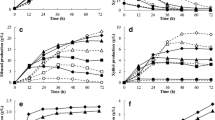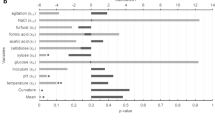Abstract
Utilization of renewable feedstocks for the production of bio-based bulk chemicals, such as 2,3-butanediol (2,3-BDO), by engineered strains of the non-pathogenic yeast, Saccharomyces cerevisiae, has recently become an attractive option. In this study, to realize rapid production of 2,3-BDO, a flocculent, 2,3-BDO-producing S. cerevisiae strain YPH499/dPdAdG/BDN6-10/FLO1 was constructed from a previously developed 2,3-BDO-producing strain. Continuous 2,3-BDO fermentation was carried out by the flocculent strain in an airlift bioreactor. The strain consumed more than 90 g/L of glucose, which corresponded to 90% of the input, and stably produced more than 30 g/L of 2,3-BDO over 380 h. The maximum 2,3-BDO productivity was 7.64 g/L/h at a dilution rate of 0.200/h, which was higher than the values achieved by continuous fermentation using pathogenic bacteria in the previous reports. These results demonstrate that continuous 2,3-BDO fermentation with flocculent 2,3-BDO-producing S. cerevisiae is a promising strategy for practical 2,3-BDO production.



Similar content being viewed by others
References
Bialkowska AM (2016) Strategies for efficient and economical 2,3-butanediol production: new trends in this field. World J Microbiol Biotechnol 32:200
Bony M, Thines-Sempoux D, Barre P, Blondin B (1997) Localization and cell surface anchoring of the Saccharomyces cerevisiae flocculation protein Flo1p. J Bacteriol 179:4929–4936
Caro LH, Tettelin H, Vossen JH, Ram AF, van den Ende H, Klis FM (1997) In silicio identification of glycosyl-phosphatidylinositol-anchored plasma-membrane and cell wall proteins of Saccharomyces cerevisiae. Yeast 13:1477–1489
Celinska E, Grajek W (2009) Biotechnological production of 2,3-butanediol: current state and prospects. Biotechnol Adv 27:715–725
Chen DC, Yang BC, Kuo TT (1992) One-step transformation of yeast in stationary phase. Curr Genet 21:83–84
Couto SR, Toca-Herrera JL (2007) Laccase production at reactor scale by filamentous fungi. Biotechnol Adv 25:558–569
Ji XJ, Huang H, Ouyang PK (2011) Microbial 2,3-butanediol production: a state-of-the-art review. Biotechnol Adv 29:351–364
Jullesson D, David F, Pfleger B, Nielsen J (2015) Impact of synthetic biology and metabolic engineering on industrial production of fine chemicals. Biotechnol Adv 33:1395–1402
Kim JW, Kim J, Seo SO, Kim KH, Jin YS, Seo JH (2016) Enhanced production of 2,3-butanediol by engineered Saccharomyces cerevisiae through fine-tuning of pyruvate decarboxylase and NADH oxidase activities. Biotechnol Biofuels 9:265
Kim S, Hahn JS (2015) Efficient production of 2,3-butanediol in Saccharomyces cerevisiae by eliminating ethanol and glycerol production and redox rebalancing. Metab Eng 31:94–101
Kim SJ, Seo SO, Jin YS, Seo JH (2013) Production of 2,3-butanediol by engineered Saccharomyces cerevisiae. Bioresour Technol 146:274–281
Lee HK, Maddox IS (1986) Continuous production of 2,3-butanediol from whey permeate using Klebsiella pneumoniae immobilized in calcium alginate. Enzyme Microb Technol 8:409–411
Ng CY, Jung MY, Lee J, Oh MK (2012) Production of 2,3-butanediol in Saccharomyces cerevisiae by in silico aided metabolic engineering. Microb Cell Fact 11:68
Nordström K (1968) Yeast growth and glycerol formation II. Carbon and redox balances. J Inst Brew 74:429–432
Ostergaard S, Olsson L, Nielsen J (2000) Metabolic engineering of Saccharomyces cerevisiae. Microbiol Mol Biol Rev 64:34–50
Ramachandran KB, Goma G (1987) Effect of oxygen supply and dilution rate on the production of 2,3-butanediol in continuous bioreactor by Klebsiella pneumoniae. Enzyme Microb Technol 9:107–111
Sikorski RS, Hieter P (1989) A system of shuttle vectors and yeast host strains designed for efficient manipulation of DNA in Saccharomyces cerevisiae. Genetics 122:19–27
Smukalla S, Caldara M, Pochet N, Beauvais A, Guadagnini S, Yan C, Vinces MD, Jansen A, Prevost MC, Latge JP, Fink GR, Foster KR, Verstrepen KJ (2008) FLO1 is a variable green beard gene that drives biofilm-like cooperation in budding yeast. Cell 135:726–737
Van Mulders SE, Christianen E, Saerens SM, Daenen L, Verbelen PJ, Willaert R, Verstrepen KJ, Delvaux FR (2009) Phenotypic diversity of Flo protein family-mediated adhesion in Saccharomyces cerevisiae. FEMS Yeast Res 9:178–190
Verbelen PJ, De Schutter DP, Delvaux F, Verstrepen KJ, Delvaux FR (2006) Immobilized yeast cell systems for continuous fermentation applications. Biotechnol Lett 28:1515–1525
Westman JO, Mapelli V, Taherzadeh MJ, Franzen CJ (2014) Flocculation causes inhibitor tolerance in Saccharomyces cerevisiae for second-generation bioethanol production. Appl Environ Microbiol 80:6908–6918
Wong CL, Yen HW, Lin CL, Chang JS (2014) Effects of pH and fermentation strategies on 2,3-butanediol production with an isolated Klebsiella sp. Zmd30 strain. Bioresour Technol 152:169–176
Xie D, Shao Z, Achkar J, Zha W, Frost JW, Zhao H (2006) Microbial synthesis of triacetic acid lactone. Biotechnol Bioeng 93:727–736
Xue C, Zhao X-Q, Liu C-G, Chen L-J, Bai F-W (2013) Prospective and development of butanol as an advanced biofuel. Biotechnol Adv 31:1575–1584
Yamada R, Taniguchi N, Tanaka T, Ogino C, Fukuda H, Kondo A (2010) Cocktail delta-integration: a novel method to construct cellulolytic enzyme expression ratio-optimized yeast strains. Microb Cell Fact 9:32
Yamada R, Wakita K, Mitsui R, Nishikawa R, Ogino H (2017) Efficient production of 2,3-butanediol by recombinant Saccharomyces cerevisiae through modulation of gene expression by cocktail delta-integration. Bioresour Technol 245:1558–1566
Zeng A-P, Biebl H, Deckwer W-D (1990) 2,3-Butanediol production by Enterobacter aerogenes in continuous culture: role of oxygen supply. Appl Microbiol Biotechnol 33:264–268
Acknowledgements
A part of this work was supported by a New Chemical Technology Research Encouragement Award from the Japan Association for Chemical Innovation and by a Grant for Basic Science Research Projects from the Sumitomo Foundation.
Author information
Authors and Affiliations
Corresponding author
Electronic supplementary material
Below is the link to the electronic supplementary material.
Rights and permissions
About this article
Cite this article
Yamada, R., Nishikawa, R., Wakita, K. et al. Rapid and stable production of 2,3-butanediol by an engineered Saccharomyces cerevisiae strain in a continuous airlift bioreactor. J Ind Microbiol Biotechnol 45, 305–311 (2018). https://doi.org/10.1007/s10295-018-2033-5
Received:
Accepted:
Published:
Issue Date:
DOI: https://doi.org/10.1007/s10295-018-2033-5




